Death! Death!! DEATH!!!
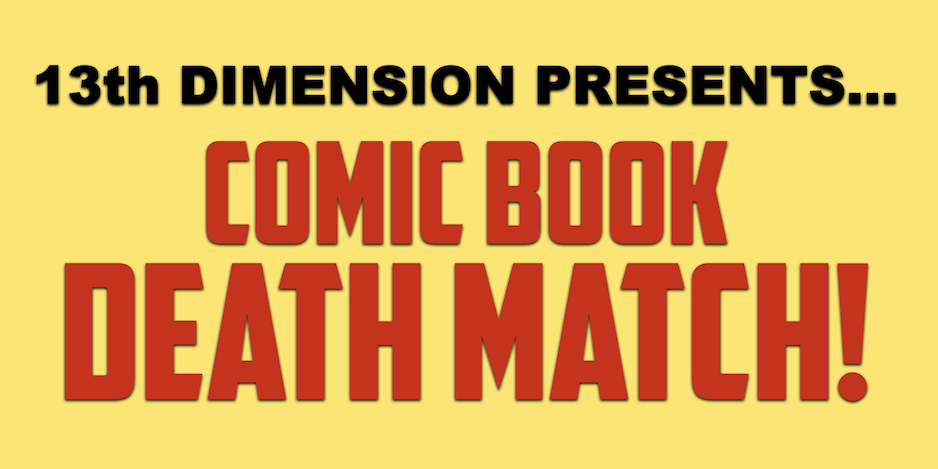
Fred Van Lente’s COMIC BOOK DEATH MATCH is back and better than ever! Now, as a monthly feature for 2024!
See, Marvel this year is celebrating the 40th anniversary of 1984’s 12-issue Marvel Super Heroes Secret Wars by re-releasing each installment as a Facsimile Edition every month. And of course, what is the DC event it’s always compared to? Why, 1985’s Crisis on Infinite Earths, of course. And that series is also being re-released monthly too. (It started in April.)
It’s a great time to revisit two maxiseries that redefined comics for good and for bad. You can click here to find the previous entries, but right now the tally stands at Secret Wars 3, Crisis 2. (The Secret Wars #6 Facsimile Edition is out this Wednesday.)
Ring the bell, Fred!
—
By FRED VAN LENTE
Marvel Super Heroes Secret Wars #6: “A Little Death…”
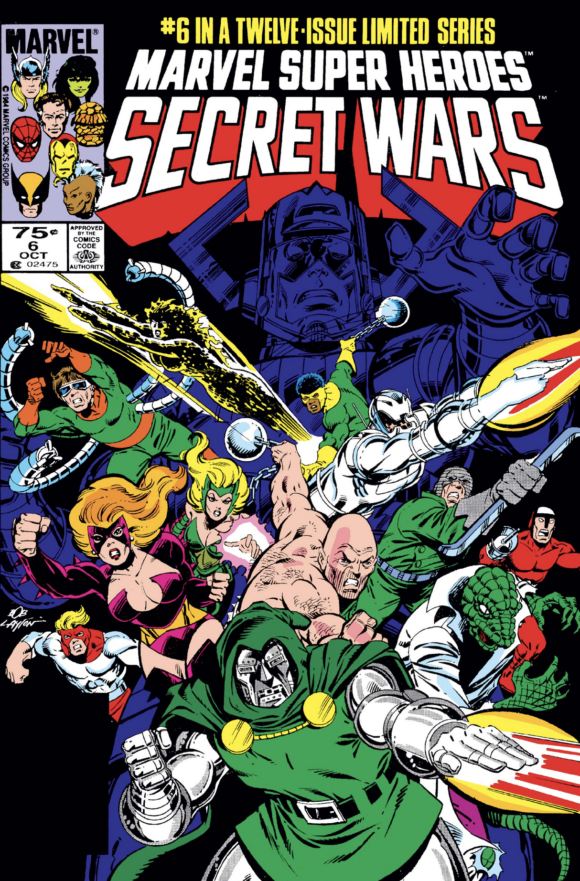
The Wasp, who’s been trying to escape from Magneto’s lair for the last two issues-plus, crashes her vessel in a Battleworld swamp and stumbles across the Lizard, whom everyone, and, I’m presuming, Shooter & Co., have forgotten about since #1. The two of them recreate the regular-person-is-nice-to-monster schtick from countless Frankenstein movies, until more villains happen by, lethally wound Wasp, and scoop Lizard up.
Damn, Janet just can’t catch a break.
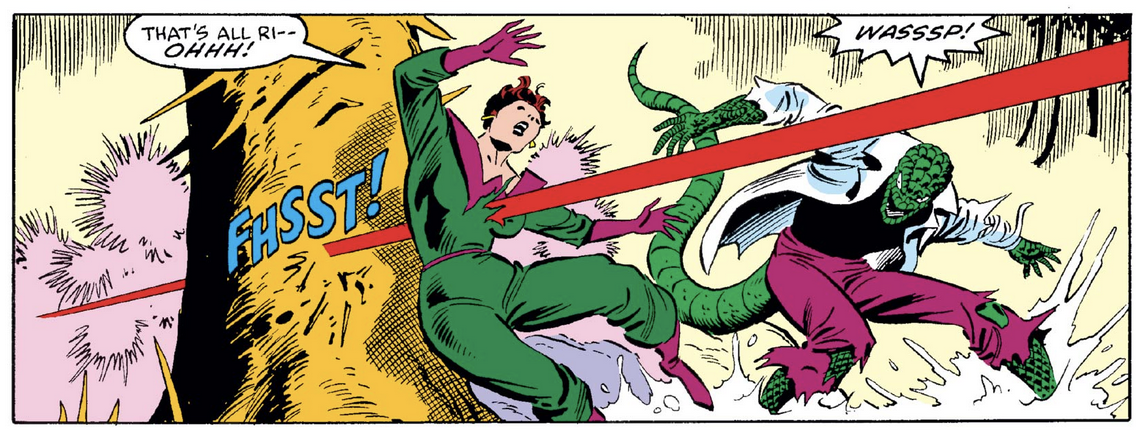
Dr. Doom, meanwhile, is wandering around Galactus’ house. “Wandering around Galactus’ house” is clearly one of Jim Shooter’s fondest dreams because, as you may recall, doing so is how Korvac gets his godlike powers in Shooter’s most beloved Avengers storyline.
Doom isn’t as lucky. Instead, he just summons Klaw, Master of Sound, who’d been zapped into Galactus’s WiFi router by Dazzler in a way too complicated for me to want to describe. Klaw’s brains have been fried in the process, and he becomes Doom’s enthusiastic thrall. Doom sends Klaw back to Battleworld with instructions for the other villains to mess up Galactus’ dinner by causing a volcanic disruption.
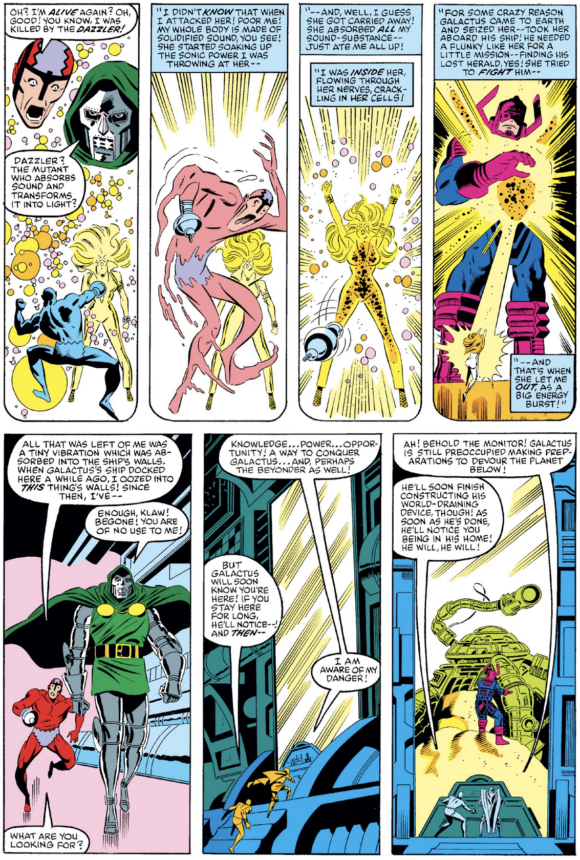
(Since Galactus converts planets to energy before eating them, I don’t understand how that’s going to slow him down, But am I a master of both science and magic like Victor Von Doom, the Lord of Latveria? Alas, Reader, I am not.)
The unrequited love triangle between Colossus, Human Torch, and alien hippie chick Zsaji continues, with Colossus’ agony hilariously rendered by the much-welcome return of Mike Zeck.
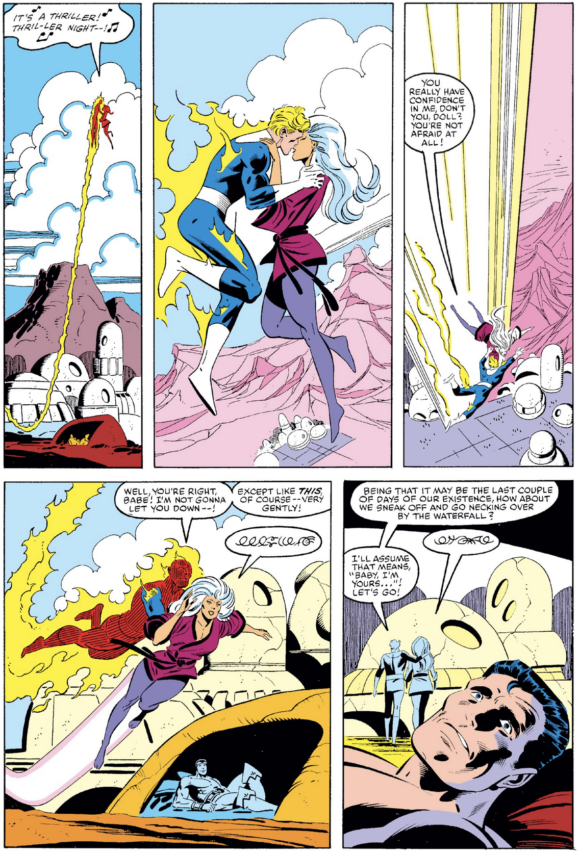
Zeck also crushes the centerpiece of the issue, which is Cyclops, Rogue and Wolverine trying to stop Titania, Dr. Octopus, Molecule Man and Absorbing Man from carrying out Doom’s plan. As Rogue notes, the X-ers are badly overmatched here, and her hesitation causes her to get knocked around pretty badly. (Also reminiscent of the hesitant neophyte Wonder Man from Shooter’s Avengers run. Lot of old standards being played at the bar tonight.)
Wolverine, not being a complete idiot, decides to take out the ridiculously powerful Molecule Man with extreme prejudice. Cyclops, who is, at least partially, an idiot, stops him, but not before Logan wounds Mr. God-Nerd badly enough that it forces the villains to retreat.
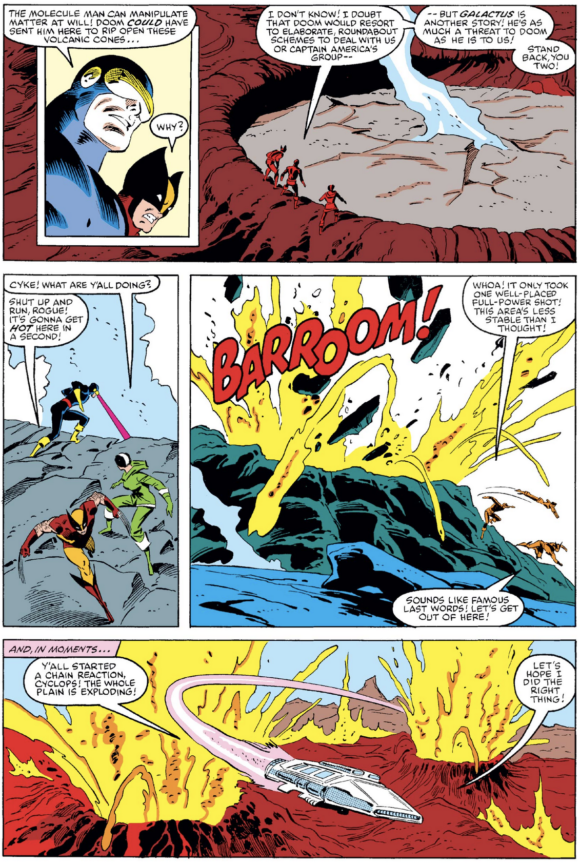
Nevertheless, Cyclops intuits what the bad guys were trying to do, and on his own initiative fulfills the villains’ plan on his own by blasting the volcanic vein with his eye beams. As is often the case with characters in this series, I have absolutely know idea why he does this. How many times in superhero comics does your protagonist go, “You know, the guy literally named ‘Doom’ has a lot of valid points, actually.”
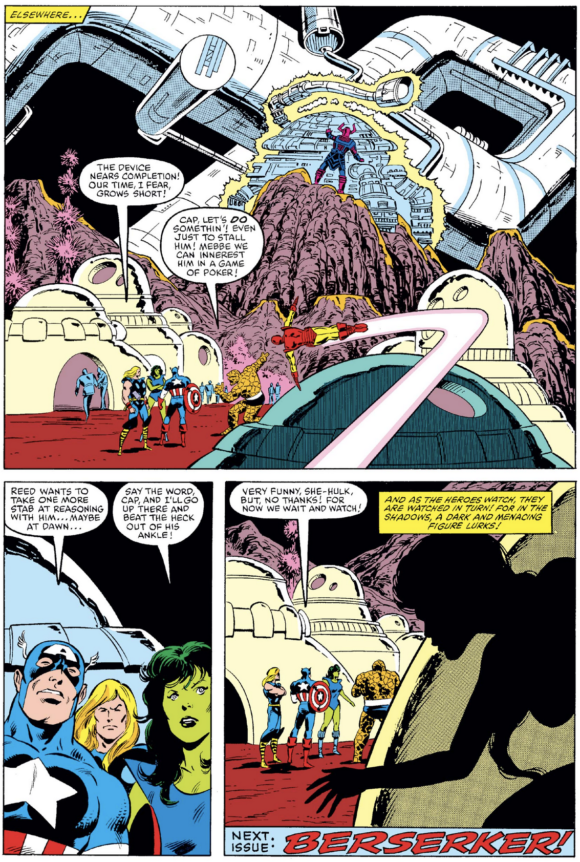
Then, back at Heroes’ Village, we are teased with the arrival of a brand-new character next issue. One that will be beloved by dozens! Dozens, I say!
—
Crisis on Infinite Earths #6: “3 Earths! 3 Deaths!”
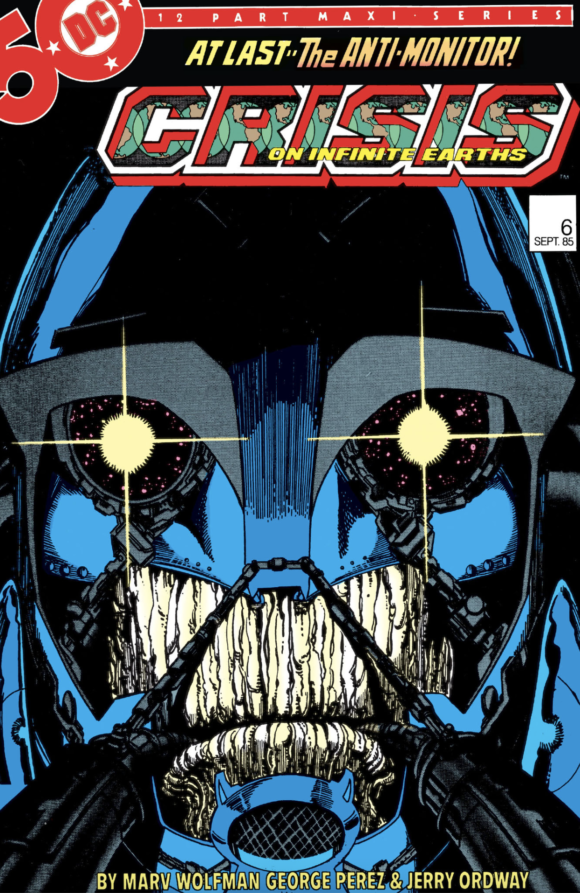
The Anti-Monitor—or, as they call him in the anti-matter universe, “The Monitor”—after constantly threatening Psycho Pirate that he can replace him at any moment with any one of the other DC mind-control people (and you thought your boss sucked) finally orders him to mind-juju heroes from three other DC Corporate-Acquisitions Earths to kill our beloved Earth-1 and Earth-2 heroes as they are scattered across the Netherverse upon the destruction of The Pro-Matter Monitor’s space station. (Holy crap, that’s a long, albeit accurate, sentence.)

Earth-X’s heroes were originally owned by Quality Comics: Uncle Sam, the Ray, and the like, many of whom were co-created by Will Eisner, pre-Spirit. Other than Plastic Man and the Blackhawks, nobody has ever liked the Quality characters, to the point where Quality itself never even bothered renewing copyright claims on any of them. DC just bought their trademarks and titles in 1956, beginning a long-running practice of Detective Comics Comics hoovering up any ol’ superheroes that happened to be lying around.
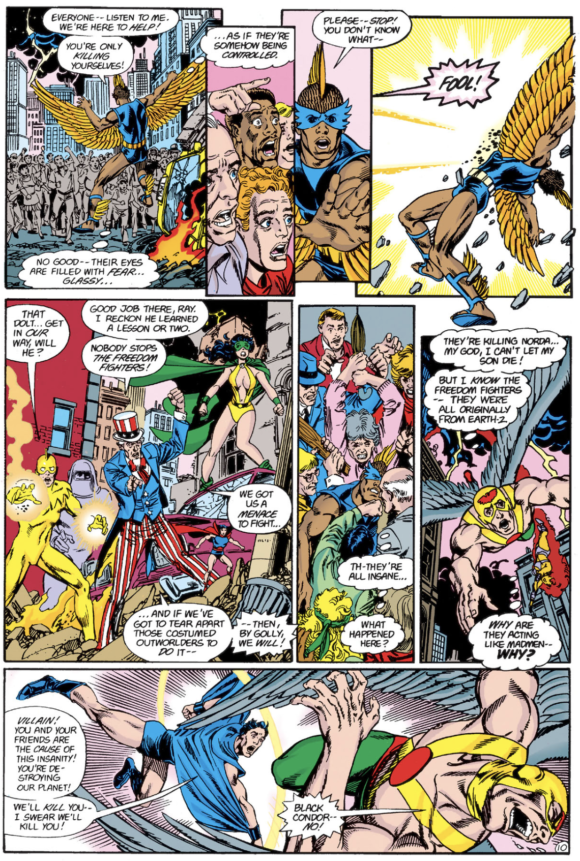
Their schtick is that in Earth-X’s timeline, the Nazis won World War II, which is one of those high concepts that sounds interesting in theory but excites few in execution. I suspect this is because, you know, we beat the Nazis here in our world, no superheroics required. I don’t want Superman to make me a sandwich. I want him to do stuff I can’t do!
Earth-S is populated by heroes formerly of Fawcett Comics, acquired by Detective Comics Comics in 1973, almost two decades after the latter successfully sued the former on the basis of a dubious copyright infringement claim against Superman’s only real competition in the Golden Age, the immensely popular Captain “Shazam!” Marvel.
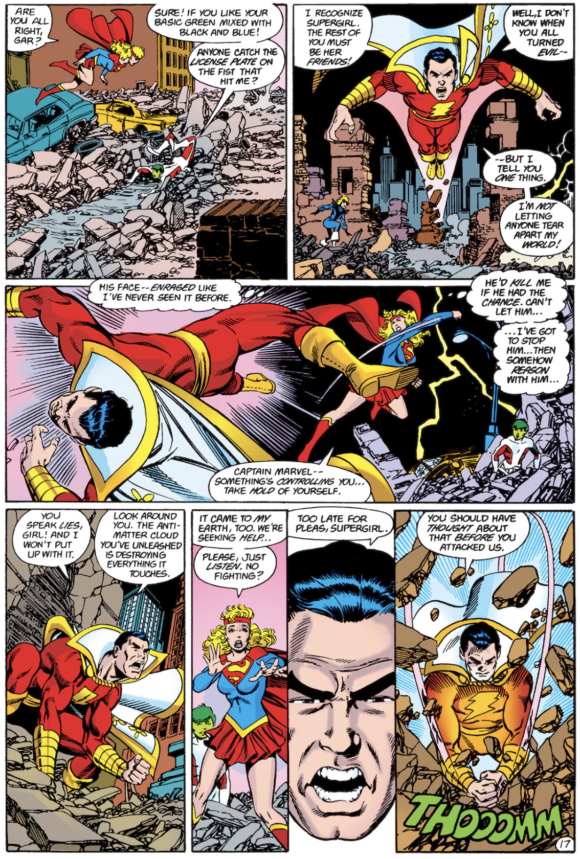
DC’s initial attempt to turn a profit on their latest acquisition was a famous disaster, not in the least of which because the creative team hated each other. The notoriously cranky C.C. Beck, #1 Most Favored Shazam! Artist, couldn’t stand Denny O’Neil and Elliot S! Maggin’s scripts and quit around Shazam! #10. The series kept going but never captured the magic of the Golden Age original.
Captain Marvel has struggled in the modern era ever since—despite a critically and commercially successful feature film—often used as someone, appropriately enough, who gets his ass kicked by Superman. It’s the superhero equivalent of the King of the Gauls getting paraded through the streets of Rome so he can get his throat slit by Julius Caesar (#PerfectHistoricalComparison).
Earth-4’s Charlton Comics heroes were swallowed by the DC Leviathan not long before Crisis on Infinite Earths started, in 1983, and have fared much better than Fawcett’s stable. The Question and Blue Beetle have become DCU mainstays, and Peacemaker was the first-ever DCEU TV show.
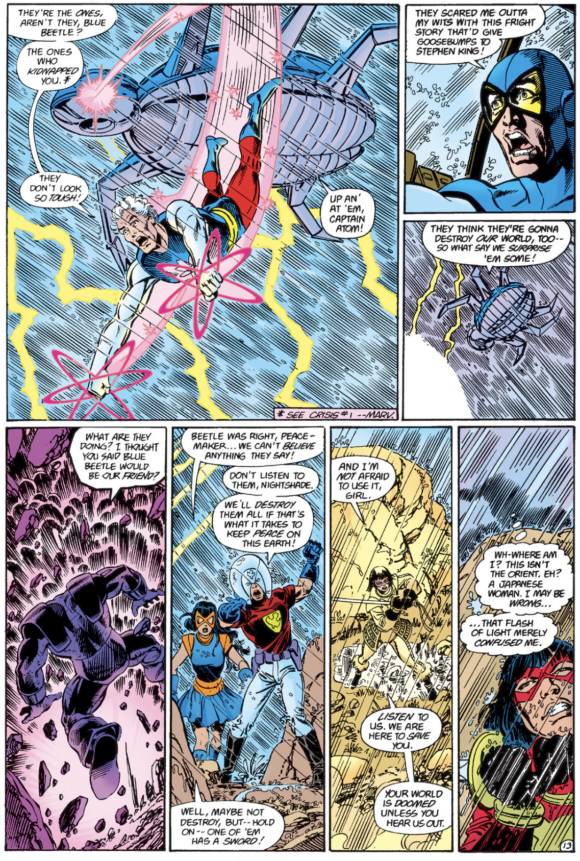
I am going to make the not-brilliant observation that this is likely because the Golden Age Marvel Family were explicitly created for children, and everything about them reflects that, and the Charlton heroes were Silver Age creations—often by a post-Marvel Steve Ditko—for a skewing-older audience, and thus mesh better into a modern superhero universe.
A universe that can support something like Crisis on Infinite Earths, come to think of it.
Like, I can imagine the thrill readers got in 1985 seeing every single superhero ever* crammed into one series. Still, I feel sorry for George Perez’s drawing hand on every page. Fortunately, he seems to have loved it, so my concern is misplaced, but still. I feel for him!
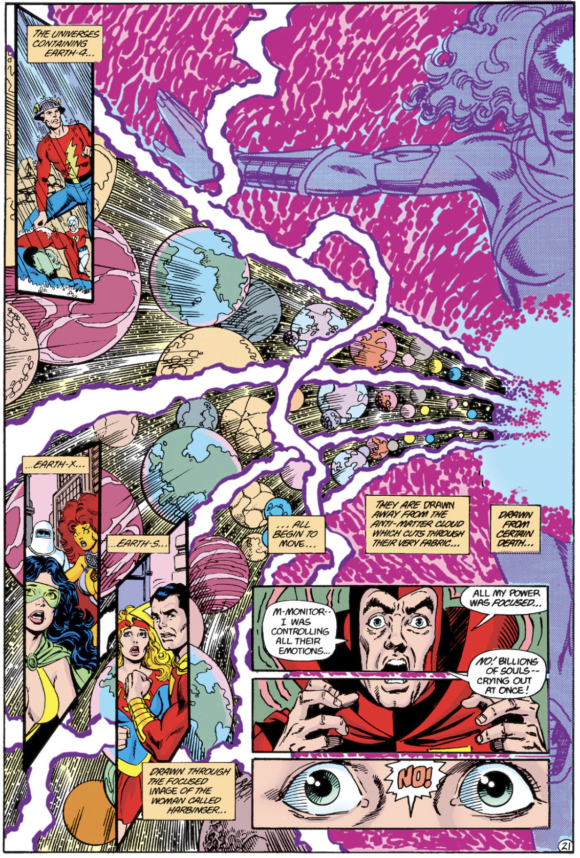
The Herculean pencilling of Perez is the main draw of this book through the first six issues, and, don’t get me wrong, it is an impressive feat of cartooning. But Man—well, this man, anyway—cannot live by a hundred character cameos alone.
Case in point: The big reveal at the end of this issue is that there’s a new Wildcat. We spend all of two panels (Reader, I went back and counted) with the original Wildcat before he got injured and needed replacing, so I find this cliffhanger… underwhelming. There’s just no space allotted to develop feeling for any one individual character.
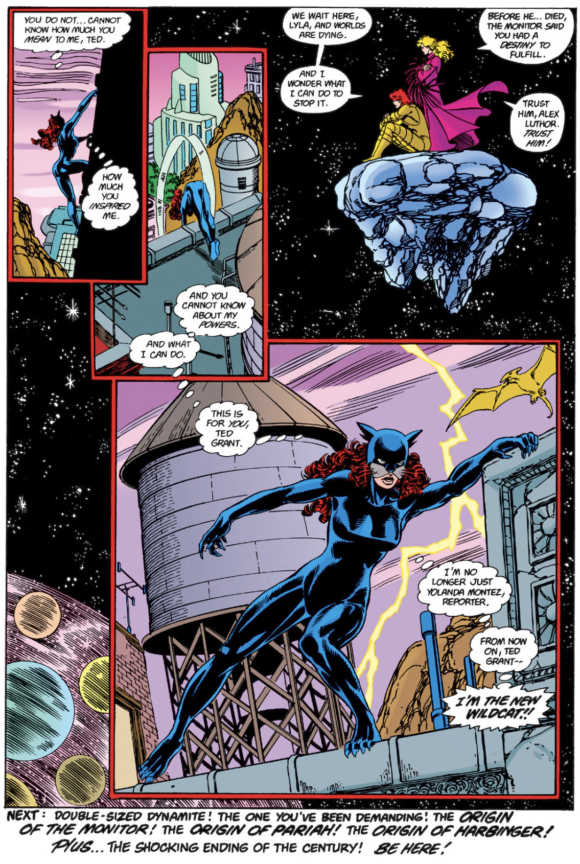
That said, when it comes to “Pointless Character Reveal,” Secret Wars says, “Hold my beer.” For that reason alone:
ROUND SIX WINNER: CRISIS
* that DC owns the rights to
—
Our Tally So Far: SECRET WARS 3, CRISIS 3
—
MORE
— COMIC BOOK DEATH MATCH: Secret Wars #5 vs. Crisis on Infinite Earths #5. Click here.
— The Complete COMIC BOOK DEATH MATCH Index. Click here.
—
13th Dimension contributor Fred Van Lente is an award-winning, New York Times-bestselling comics writer, as well as an occasional novelist, teacher, and playwright. Sign up for updates on his upcoming projects and check out the trailer for his comics-writing course at his web site, fredvanlente.com.

June 2, 2024
“… nobody has ever liked the Quality characters.” So not true for this child fan of the ‘70s. I loved their appearances in the JLA title.
June 3, 2024
I have a general love for all these golden age characters. I would have loved to have seen them all at greater length in All-Star Squadron
June 3, 2024
An All-Star Squadron Omnibus, where do I send my check for that?! Would not need to think too hard on that decision to buy.
June 2, 2024
Freedom Fighters was one of the very few DC series this Marvel fan actually bought regularly in the ’70s, and now that I’ve read some of the original Quality comics, I’m even more of a fan than I was. For the record:
Freedom Fighters members who were better/more interesting in the original Golden Age Quality comics: Doll Man, Phantom Lady, Uncle Sam
Freedom Fighters who were better/more interesting in DC’s Bronze Age take: The Ray, the Black Condor, the Human Bomb.
Just my opinion, of course.
June 3, 2024
I quite like Uncle Sam, the Ray, and Doll Man, and Black Condor had some great art, at least. The idea that the Nazis won WWII with a wrecking machine like Uncle Sam around is simply absurd.
“It’s the superhero equivalent of the King of the Gauls getting paraded through the streets of Rome so he can get his throat slit by Julius Caesar”
Or a top wrestler in one promotion getting jobbed out to Hulk Hogan after signing with WWF.